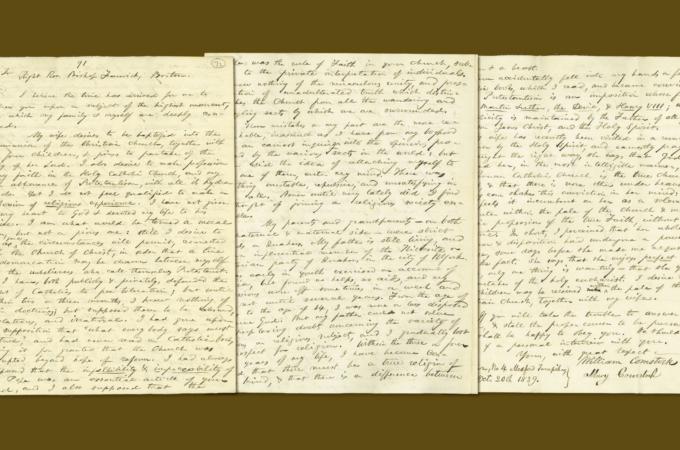An early Boston convert to Catholicism
On Oct. 20, 1839, William Comstock wrote to Bishop Benedict Fenwick of Boston from his home at Number Four, Medford Turnpike, Charlestown. He reveals that his wife Mary, along with himself and their four children, desire to enter the Catholic Church and hopes the bishop will grant them an interview to discuss this prospect.
William relates how his "wife has recently been visited in a remarkable manner by the Holy Spirit, and (is) earnestly praying to be taught the right way. God has assured her, in the most intelligible manner," he continues, "that the Roman Catholic Church is the true Church of Christ, and that there is none other under heaven." After this event nothing can shake her belief, he relates to the bishop, and she enjoys a perfect happiness with the exception that she "yearns to partake of the holy Eucharist."
William continues to provide an account of his own history and what has brought him to the point of converting to Catholicism. His parents and grandparents were all members of the Society of Friends, known commonly as the Quakers, and, at the time of writing, his father was a prominent member of that community in New York City. In his youth, William was "an earnest inquirer into the opinions professed by the various sects in the world" but never thought of converting. In fact, it is implied he revealed he received a rigorous religious education but continued to express doubts over the many opinions presented by each sect, and therefore lost respect for all religions.
His journey towards the Catholic faith began three or four years prior to writing, when he came to the realization that there must be one true religion, and coincidentally came upon several Catholic books, which he began to read. Though he had been tolerant of and even defended Catholics, he held the opinion that they were "absurd, idolatrous, and irrational," notions based upon his "supposition that what everybody says must be true." Admittedly, he had no knowledge of Catholic doctrine, and after reading the books found he was mistaken and became convinced that the Catholic Church was the one true Church.
While he considers himself a moral man, he says he is not a pious one, as he has not "given up my heart to God and devoted my life to his service." And while he cannot make a profession of religious experience like his wife, still hopes to make a profession of faith so that "a line of demarcation may be drawn between myself and the unbelievers who call themselves Protestant."
Sadly, no further correspondence exists between William Comstock and Bishop Fenwick, nor is there a record of the family's conversation in the diocesan archive. Nonetheless, this letter on its own still holds tremendous value in terms of understanding early Catholic converts.
Prior to the large influx of Catholic immigrants in the mid-19th century, converts spurred the growth of both the laity and clergy in what was a relatively small community. While records of conversions exist both in written accounts and sacramental records, this letter provides valuable insight into the motivations behind these conversations. In the case of Mary Comstock, it was a visit from the Holy Spirit, a direct encounter which led her to the Catholic Church and a desire to receive the holy Eucharist. In William's case, he had a long history of questioning religion, but was inspired by what he read in books about Catholicism and wished to enter the Church together with his wife and four children.
- Thomas Lester is the archivist of the Archdiocese of Boston.



















